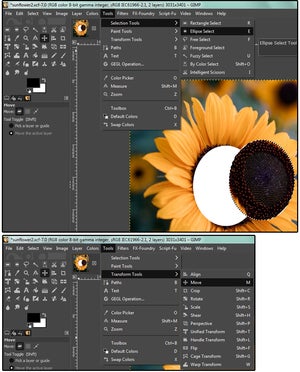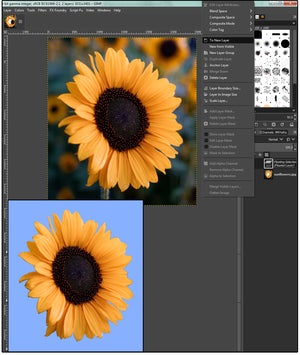GIMP (GNU Image Manipulation Program), like so many other open source programs, started out as a student project at the University of California, Berkeley. It was developed by Spencer Kimball and Peter Mattis in 1995, and the first version (0.54) was released in 1996.
As of the current version (2.10) GIMP has matured into a truly incredible photo-editing program. It’s not as complex as Photoshop, but it’s not as basic as PC Paint either. It rivals all the top dogs on the market today. Best of all, it’s free!
If you’re coming at GIMP by way of Photoshop, however, you may be frustrated by the some of the differences. Here are a few user tips to get you started, whether you're a rookie or a pro.
Tip 1: Read the tutorials
Who has time to read the tutorials? Photoshop, Paintshop Pro, or Corel Paint users will end up saving some time if they do, because GIMP's menus are very different. There are over a dozen tutorials on the GIMP Tutorials page on the GIMP.org website. While I advise you to review them all, these two (including one from another site) will get you started:
- The Basics Tutorial from GIMP.org
- GIMP Tutorials from How to GIMP
Tip 2: Reassign the shortcut keys
If Photoshop and its keyboard shortcuts are part of your muscle memory, you can reassign the GIMP shortcut keys to match Photoshop's. To remap your keyboard shortcuts in GIMP, select Edit > Keyboard Shortcuts, and the Configure Keyboard Shortcuts dialog window opens. Follow the instructions beside the lightbulb at the bottom of the window, then click Save.
GIMP adds the new reassigned shortcut to the correct GIMP menus, so you can always see what they are. Notice that some of the shortcut keys are the same in both programs such as Copy, Cut, Paste, etc.—a CUA (Common User Access) standard that still applies.
 JD Sartain / IDG
JD Sartain / IDG
Reassign GIMP shortcut keys to match Photoshop
Tips 3 & 4: Selection and Transform tools
Looking for the Pointer tool (that moves objects) or the Hand tool (that moves the image around inside the active window), like in Photoshop? Sorry. There is no Hand tool in GIMP, and don’t look for the Pointer/Move tool in the Selection menus. The Move tool is in Tools > >Transform Tools > Move.
Use a Selection tool (Tools > Selection Tools) to draw a circle, rectangle, or square; or use the Free Select tool (Tools > Selection Tools > Free Select) to outline an existing object.
Next, choose Tools > Transform Tools > Move. The cursor changes into the crosshairs symbol, but before you can use it, ensure that Move the Active layer is checked in the Move panel on the left side of the screen. Then click and drag.
At this point, it’s just a Floating object (notice the description in the Layers palette on the right side of the screen. Right-click the layer called Floating Selection/Floated Layer in the Layers palette, then choose To New Layer from the popup menu. Now the object you created or selected from the photograph resides in its own layer, so you can change the color, resize it, add a filter, or edit it in a hundred different ways. A lot different from Photoshop, but not so confusing once you’ve tried it a few times.
 JD Sartain / IDG
JD Sartain / IDG
Using the Selection and Transform tools
Tip 5: Removing backgrounds
It’s easy to remove the background if it's a single color and the foreground object is considerably lighter or darker than the background color, or the foreground object’s colors are fairly simple such as a yellow sunflower, a red umbrella, or a blue wagon.
Of course, the colors in photographs are rarely that basic. A sunflower can have nine shades of yellow, and that’s okay, as long as it doesn't have any of the same colors used in the background.
If the sunflower has white streaks and the background is white, using the Fuzzy Select tool (called the Magic Wand in Photoshop) will be harder because it will select the white background AND the white streaks in the sunflower. If the background is real busy with dozens of images and colors such as a train station full of people or a garden full of plants, you’ll be clicking that Fuzzy Select tool 50 times or more. It’s not as simple as many of the online tutorials claim.
Because most photos have busy backgrounds and millions of colors, the trick is to use a combination of tools to cut the object in the “foreground” out of the background, then delete or replace the background. You can start with the Fuzzy Select tool, then fine-tune the selection with the Free Select tool (called the Polygonal Lasso in Photoshop). Hold down the Shift key to add to your selection.
Or, you can just use the Free Select tool, outline the object, select Cut, then Paste As > New Layer. But don’t forget, you must right-click that layer in the Layers palette, and choose To New Layer from the popup menu before it becomes an actual layer.
NOTE: If the edges on your new layer are a little rough, choose Select > Border. When the Border Selection dialog opens, choose 2 px in the Border Selection By field, then choose Smooth.
 JD Sartain / IDG
JD Sartain / IDG
Removing backgrounds
Tip 6: Resizing photos without losing image quality
This is one of the most important photo tips, because everybody who prints digital photos must understand how to resize them.
Most digital cameras shoot photos at a low resolution such as 72, 120, or 180 ppi (pixels per inch), unless you access the Settings menu and change it to a higher resolution setting such as 300 to 600 ppi. The larger the photo, the higher the ppi must be to avoid losing image quality. Generally, 300 ppi is adequate for an 11x14 print. Larger sizes would need more pixels.
Resizing in Photoshop is handled through Image > Image Size. If you uncheck the Resample Image box, you can change the 72 ppi to 300 ppi, and the physical image size will automatically change to match the new ppi. This method preserves the image quality.
In GIMP, the command is Image> Scale Image. The Scale Image dialog appears showing the Image Size (width and height), the Resolution (X and Y), and the Quality Interpolation. To automatically adjust the physical image size when the ppi changes, choose NoHalo from the Interpolation field.
NOTE: The NoHalo and LoHalo options replaced the Sinc (Lanczos3) option in previous versions.
First, change the pixels to inches, then choose NoHalo, then enter 300 in the X Resolution field box. All the other relevant fields change automatically to maintain the image quality. When finished, click the Scale button and it’s done.
 JD Sartain / IDG
JD Sartain / IDG
Resizing photos
















